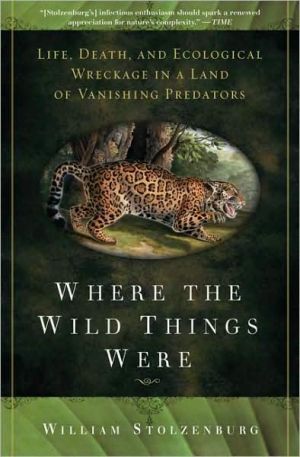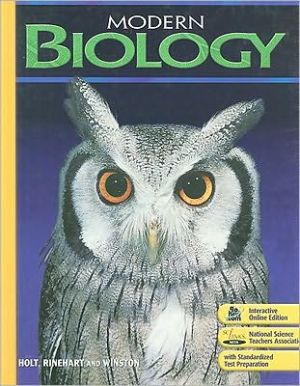Where the Wild Things Were: Life, Death, and Ecological Wreckage in a Land of Vanishing Predators
“Big, fierce animals have a noble champion in William Stolzenburg.”—Edward O. Wilson, Professor Emeritus, Harvard University\ Wildlife journalist William Stolzenburg follows in the wake of nature’s topmost carnivores and finds chaos in their absence. His startling tour through the bizarre, impoverished landscapes of pest and plague provides a world of reason to think again about meat-eating beasts so recently missing from the web of life. Includes a new afterword by the author.
Search in google:
A provocative look at how the disappearance of the world’s great predators has upset the delicate balance of the environment, and what their disappearance portends for the future, by an acclaimed science journalist.It wasn’t so long ago that wolves and great cats, monstrous fish and flying raptors ruled the peak of nature’s food pyramid. Not so anymore. All but exterminated, these predators of the not-too-distant past have been reduced to minor players of the modern era. And what of it? Wildlife journalist William Stolzenburg follows in the wake of nature’s topmost carnivores, and finds chaos in their absence. From the brazen mobs of deer and marauding raccoons of backyard America to streamsides of Yellowstone National Park crushed by massive herds of elk; from urchin-scoured reefs in the North Pacific to ant-devoured islands in Venezuela, Stolzenburg leads a startling tour through bizarre, impoverished landscapes of pest and plague. For anyone who has seldom given thought to the meat-eating beasts so recently missing from the web of life, here is a world of reason to think again. Publishers Weekly In this impassioned debut, wildlife journalist Stolzenburg examines predation's crucial role in the preservation of ecological diversity, painting nightmarish pictures of what happens when top carnivores are exterminated from ecosystems. Without sea otters to keep ravenous sea urchins in check, some ocean floors in the North Pacific have been stripped of kelp. In Yellowstone National Park, the eradication of wolves has resulted in a glut of elk that have trampled river banks and chewed down young trees. White-tailed deer have denuded the undergrowth in the forests of the eastern United States, because wolves and cougar have disappeared. Without large meat eaters, mid-size predators-raccoons, blue jays, crows, squirrels, opossums-have proliferated, to the detriment of songbird populations. In dazzling descriptions, Stolzenburg demonstrates how the delicate balance between predator and prey is so essential, and his book, rich in dramatic accounts of life and death in the wild, is powerful and compelling. (July)Copyright © Reed Business Information, a division of Reed Elsevier Inc. All rights reserved.
Prologue: The Grizzly in the Room 11 Arms of the Starfish 62 Planet Predator 273 Forest of the Sea Otter 514 The Whale Killer 645 Ecological Meltdown 846 Bambi's Revenge 1007 Little Monsters' Ball 1208 Valley of Fear 1349 The Lions of Zion 15610 Dead Creatures Walking 16811 The Loneliest Predator 184Epilogue: Alone on the Hill 202Acknowledgments 219Notes 223Bibliography 231Index 279
\ From Barnes & NobleBarnes & Noble Discover Great New Writers\ Where the Wild Things Were is a challenging and provocative study of the importance of predation. Successful ecosystems -- which ultimately support humanity -- require top predators, so-called nuisance animals like gray wolves, jaguars, pumas, and sharks. Contrary to the lore that surrounds such animals, they're not indiscriminate killers. That title rightly belongs to Homo sapiens, the sole creatures with the ability and determination to put immediate gratification above the long-term health of our environment. Our own instincts, it seems, are borne primarily of cowardice and greed: when an animal scares us, competes with our interests, or boasts a soft pelt or ivory tusks, we shoot, poison, trap, electrocute, or simply squeeze it out of existence. \ \ Stolzenburg recounts many carefully researched examples of predator eradication and its disastrous aftermath, including the eventual extinction of everything from the smaller prey species to trees. In every case, the unintended consequences are nearly impossible to predict, but will most certainly wreak ecological havoc on animal and plant life alike. \ \ This is a humbling book because in its vivid descriptions of wild kingdoms past we see what might have been the natural world of today. Yet it is also a hopeful book because it may still be possible to turn the tide against the mass extinctions we've set in motion, and begin to heal the planet. (Fall 2008 Selection)\ \ \ \ \ Library Journal - BookSmack!\ Readers who appreciate Vaillant's exploration of the impact of poaching on the tiger population should equally appreciate Stolzenburg's deftly written exploration of the role of top predators in maintaining ecological diversity. The author, a wildlife journalist, clearly and engagingly explains what happens when an ecosystem's top predator is wiped out. A chain of cause and effect unfurls as a kind of animal deregulation takes hold. The extermination of wolves, for example, means elk have free reign, which means forests fail as young trees are consumed in numbers too high to be sustainable. Vaillant fans will embrace Stolzenburg's fine science writing and ecological message. . Neal Wyatt, "RA Crossroads," Booksmack! 10/7/10\ \ \ In this impassioned debut, wildlife journalist Stolzenburg examines predation's crucial role in the preservation of ecological diversity, painting nightmarish pictures of what happens when top carnivores are exterminated from ecosystems. Without sea otters to keep ravenous sea urchins in check, some ocean floors in the North Pacific have been stripped of kelp. In Yellowstone National Park, the eradication of wolves has resulted in a glut of elk that have trampled river banks and chewed down young trees. White-tailed deer have denuded the undergrowth in the forests of the eastern United States, because wolves and cougar have disappeared. Without large meat eaters, mid-size predators-raccoons, blue jays, crows, squirrels, opossums-have proliferated, to the detriment of songbird populations. In dazzling descriptions, Stolzenburg demonstrates how the delicate balance between predator and prey is so essential, and his book, rich in dramatic accounts of life and death in the wild, is powerful and compelling. (July)\ Copyright © Reed Business Information, a division of Reed Elsevier Inc. All rights reserved.\ \ \ \ \ As the title implies, this work is an examination of a world without the top predators of an ecological niche. Exploring the history of predation from the first microscopic predator through the age of the dinosaurs to today's modern mammals, science writer Stolzenburg, who has studied predator-control techniques and monitored endangered species, reveals the devastating ecological consequences that result (e.g., marauding deer and raccoons in suburban backyards, huge herds of elk in Yellowstone Park) once a top predator is removed from its position. Throughout, Stolzenburg follows the studies of several ecologists looking at the food chain from the top down and furnishes hard-core evidence that an ecosystem is more diverse with the top predator acting as a checks-and-balances measure to provide multiple-prey species with the chance to survive. A comprehensive bibliography offers both professional and amateur ecologists, naturalists, and biologists further readings to learn more about predator-prey interactions. The easy-to-read and captivating prose will introduce readers to species of animals they've never heard of before, as well as give a greater awareness and appreciation for the complexity of the world in which we live. Highly recommended for all libraries.\ —Kyrille Goldbeck\ \ \








